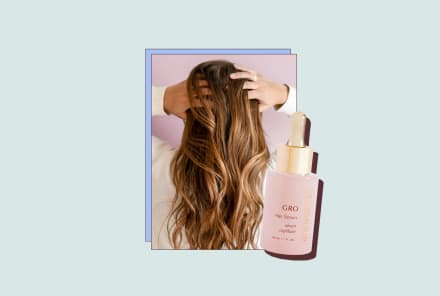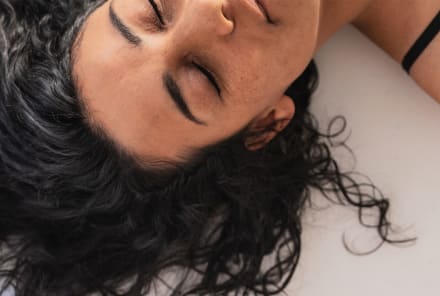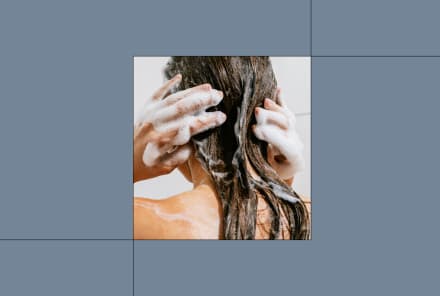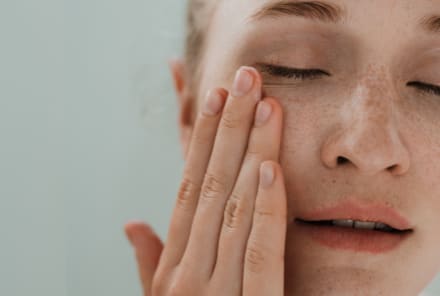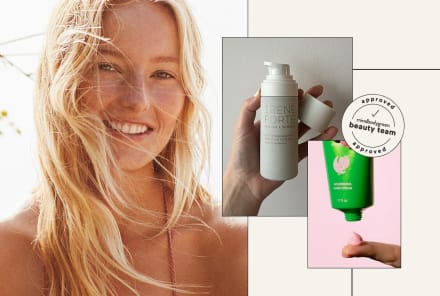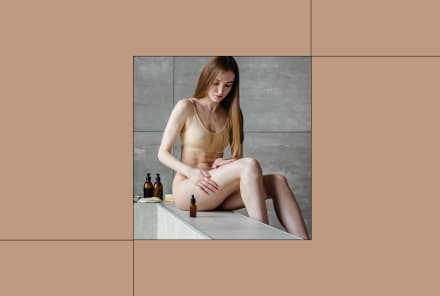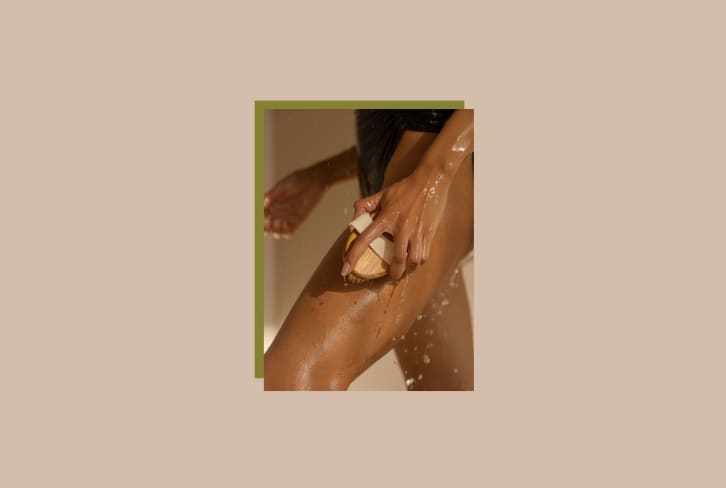Advertisement
Does Working Out Cause Acne — Or Does It Help Skin?

Hannah Frye is the Assistant Beauty Editor at mindbodygreen. She has a B.S. in journalism and a minor in women’s, gender, and queer studies from California Polytechnic State University, San Luis Obispo. Hannah has written across lifestyle sections including health, wellness, sustainability, personal development, and more.

Acne is a complicated, chronic skin condition with many influencing factors. Tons of things can trigger breakouts, from topical products to diet and even mental wellness. Because it's so challenging to identify the root cause and various triggers of acne, people tend to question whether their daily habits influence breakouts.
One of the most common questions: Does working out cause acne? We asked the experts, so here's everything you need to know.
Does working out cause acne?
The quick answer: No, working out does not directly cause acne. However, certain factors that come along with exercise can trigger breakouts, so we'll walk you through those possible influences:
Working out in your makeup or heavy moisturizers.
The first thing you should know is: Working out in your makeup should be avoided if possible. "I recommend avoiding occlusive, thick moisturizers and full-coverage foundations or other heavy makeup," board-certified dermatologist Kim Nichols, M.D., FAAD, tells mbg.
When you lather on makeup or a heavy moisturizer (face oils included), sweat and bacteria can get trapped in your skin leading to irritation and an increased risk of breakouts, clogged pores, and the like.
Waiting too long to cleanse your skin.
While an immediate cleanse is ideal, there may be a grace period. "In my opinion washing the skin after a workout within 30 minutes should be OK before the pores theoretically close back down and trap all the sweat and dirt, and possible overgrowth of bacteria and yeast start to brew," board-certified dermatologist and director of cosmetic dermatology at Montefiore Einstein Advanced Care Kseniya Kobets, M.D., tells mbg.
Washing your skin after a workout isn't always easy, especially if you live far away from your chosen place of exercise. However, there are travel-friendly tools available. "If you don't have time to do a full cleanse and routine, I recommend at least doing a quick rinse on the face with lukewarm water and carrying salicylic or glycolic acid pads," Nichols says.
But if sweat isn't inherently bad for your skin, why is it so essential to cleanse it after? "Sweat opens up pores, clearing out excess dirt and sebum in the process," Nichols says.
"In essence, this promotes healthier skin—but when skin is left uncleansed post-sweat, it allows all of that dirt and oil to be reabsorbed, further clogging pores and causing breakouts," she adds.
In addition, this can lead to something called "fungal acne." Despite its confusing moniker, fungal acne is not acne, but rather a type of folliculitis (inflammation of the hair follicle) that happens when yeast becomes trapped inside of hair follicles, leading to pimple-like bumps.
Don't worry, we'll walk you through a full post-workout skin care routine in the next section.
Washing your face too much.
Washing your face is an obvious must, but you can certainly overdo it. If you wash your face more than twice a day, you run the risk of starving your skin of moisture and natural oils—two things necessary to keep your skin healthy.
When your skin is too dry, it will naturally produce more sebum (the sticky stuff that clogs your pores). When this happens, your chance of breaking out is even higher—which is why moisturizing is always an essential part of your cleansing routine.
To avoid overwashing the skin, try to schedule your workout before your morning or evening cleanse. This isn't always possible, but it's worth a shot if you notice your skin beginning to dry out from the extra rinse.
Using dirty towels or equipment.
If you use a towel during your workout to wipe off sweat, make sure you're washing it after every single workout. Otherwise, you'll be simply spreading bacteria on your skin again and again.
The same thing applies to the clothes you wear (especially if you're prone to chest or back acne) and the equipment you're using. If your gym doesn't have a sanitizing spray there, bring one in your bag to clean off any equipment that will touch your skin.
And it's a good idea to wash your hands before working out, so that if end up wiping your brow with the back of your hand, you're doing so with a clean surface.
How working out can help your skin.
Let's be clear: Working out is actually good for your skin, and so is getting a good sweat session in. "Working out is so beneficial for our mind and body, it would be a shame to avoid exercising because it happens to worsen acne," Kobets says.
To be more specific, here are a few reasons exercise is actually a skin-loving activity:
- It reduces stress: "When we release tension through physical exercise or even stretching, our bodies are more relaxed and produce less of the hormone cortisol, which in excess amount can actually cause acne and other deleterious effects on our bodies," Kobets explains.
- It improves circulation: Movement improves circulation, which will benefit skin. Our circulatory system and blood flow bring necessary nutrients, oxygen, and minerals to the whole body, skin included1.
- It helps you sleep: Countless studies have shown that exercise can improve sleep quality and duration2. And if you lose sleep night after night, that deprivation can induce oxidative stress and lower your antioxidant defenses, making the body (and skin) vulnerable to oxidative damage.
- Sweat is good for pores: As mentioned above, sweating actually opens the pores, allowing excess bacteria and dirt to get out of your skin. Yes, you should cleanse off the sweat, but know that it's actually a form of detoxification for your skin.
- It stimulates collagen: "Workouts provide an internal kick-start for collagen production, a protein integral to keeping skin plump and youthful in appearance," Nichols says.
How to care for your skin before, during & after your workout.
Whether or not you experience breakouts from your exercise routine depends on how you tend to the skin. To follow, exactly what to do before, during, and after your workout.
Before your workout:
- Remove makeup if needed: If you're wearing makeup, be sure to remove it pre-workout. You can opt for a full face cleanse or remove it with micellar water and give your skin a good rinse.
- Skip the makeup wipes: "I would specifically avoid using makeup wipes before sweating if you are not washing skin right after. Most makeup wipes have preservatives, irritants, and allergens, which if not yet, will eventually cause an allergic or irritant contact dermatitis and may worsen acne," Kobets says.
- Wear sunscreen if necessary: If you are working out in an outdoor area or close to an open window, be sure to put SPF on your skin before you begin.
- Use a lightweight moisturizer: As previously noted, using heavy or occlusive moisturizers can lead to an increased chance of clogged pores. Instead, opt for something lightweight, like a water-based moisturizer or gel-cream formula.
During your workout:
- Sanitize your tools: Be sure to bring your sanitization spray with you if you're going to the gym, or use one available to you. If you can, try not to let your face touch your yoga mat or other surfaces if they haven't been fully sanitized.
- Let the sweat out: While sweat dripping down your face can be somewhat annoying, sometimes it's best to just let it happen. If you don't have a clean towel on hand, then you shouldn't wipe anything on your skin—as your pores are more susceptible to absorbing bacteria and dirt.
After your workout:
- Wash your face: Within half an hour, wash your face with a gentle cleanser. If you're working out in the evening or the morning (read: not a third wash of the day), Nichols recommends using an oil cleanser before your normal face wash to help remove all of the dirt you can.
- Use calming ingredients: If your skin is flushed post-workout, look for calming ingredients in your topical care. Focus on hydrating humectants like hyaluronic acid and aloe vera, and mix in anti-inflammatory ingredients like panthenol, hypochlorous acid, calendula, etc. If you're exercising in the morning, follow up with a vitamin C serum and sunscreen.
- Hydrate your skin: A moisturizer should always be applied post-cleanse, even if it's just a quick rinse. Which hydrating product you use will depend on when you're cleansing your skin—opt for a lighter moisturizer during the day and a heavier cream in the evening to lock in moisture while you sleep.
- Bonus step: Use an ice roller. If your skin is extra flushed or you can't escape the heat post-workout, an ice roller can help you and your skin cool down ASAP. If you don't have one on hand, dunking your face in a bowl of ice water for 30 seconds will do the trick as well.
How to address body acne.
When clothing occludes the skin during a workout, the chance of triggering breakouts is heightened. Body acne, like that on the chest and back area are extremely common for those who exercise and sweat often, so keep these tips in mind if this applies to you:
- Shower after intense workouts.
- Only use clean workout gear.
- Opt for plant-based protein powders rather than whey formulas.
- Use a body wash with salicylic acid.
- Try a body mask with charcoal or clay.
- Avoid comedogenic body moisturizers.
For a deeper dive into each of these tips (and more!), check out our back acne guide here.
What is fungal "acne"?
If you've done all of the above with little to no success, you might be dealing with fungal "acne." Mind the quotes because these tiny red bumps aren't actually classified as acne, but they may look similar at first.
Not sure how to tell? Here's a quick list of fungal-"acne"-defining traits:
- Presents itself as many small red bumps
- Centered around hair follicles
- May itch
- Localized on the chest, back, arms, and forehead
- Caused by yeast
- Consistent appearance (monomorphic)
This kind of "acne" requires different care entirely, so read up on what you can do here if you think you might be dealing with this skin condition.
FAQ
Does working out cause hormonal acne?
No, working out does not cause hormonal acne. In fact, exercise has been shown to reduce the stress hormone in the body called cortisol. When your body has raised cortisol levels, your skin produces more sebum (the sticky stuff that can clog your pores), which is just one of the reasons exercise is actually beneficial for hormonal acne and other forms of breakouts.
How can you prevent chest acne from working out?
To mitigate chest breakouts, be sure to do the following: Shower after your workout, use a salicylic acid body wash, only work out in clean clothes, sanitize equipment that touches the skin, swap out whey protein for a plant-based option, and see a dermatologist if none of the above work for you.
I started working out and then started breaking out, what should I do?
If you recently started exercising to be met with increased breakouts, pay attention to your skin hygiene habits. Shower after your workout, use a salicylic acid body wash, only work out in clean clothes, sanitize equipment that touches the skin, swap out whey protein for a plant-based option, and visit a board-certified dermatologist if you can.
The takeaway.
It's valid to wonder if exercise can cause acne, but rest assured the direct link is not present. However, increased sweat and bacteria on the skin triggered by exercise can lead to breakouts, so always cleanse your skin after you work out, and sanitize any equipment you're using. Want to dive even deeper? Check out our Beauty Breakdown on exercise and skin here.
Watch Next
Enjoy some of our favorite clips from classes
Enjoy some of our favorite clips from classes
What Is Meditation?
Mindfulness/Spirituality | Light Watkins
Box Breathing
Mindfulness/Spirituality | Gwen Dittmar
What Breathwork Can Address
Mindfulness/Spirituality | Gwen Dittmar
The 8 Limbs of Yoga - What is Asana?
Yoga | Caley Alyssa
Two Standing Postures to Open Up Tight Hips
Yoga | Caley Alyssa
How Plants Can Optimize Athletic Performance
Nutrition | Rich Roll
What to Eat Before a Workout
Nutrition | Rich Roll
How Ayurveda Helps Us Navigate Modern Life
Nutrition | Sahara Rose
Messages About Love & Relationships
Love & Relationships | Esther Perel
Love Languages
Love & Relationships | Esther Perel
